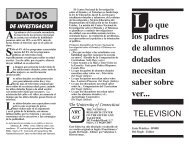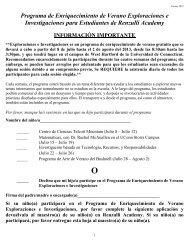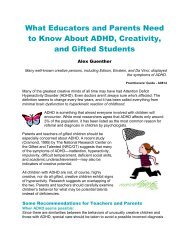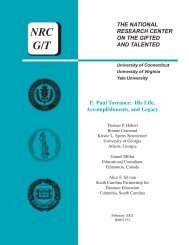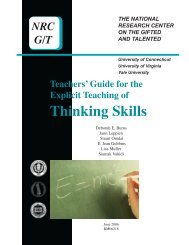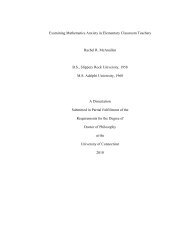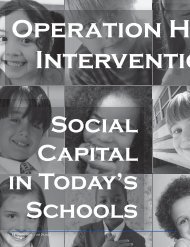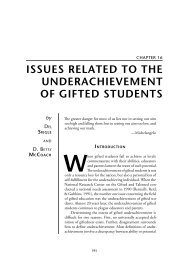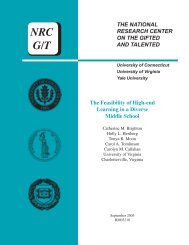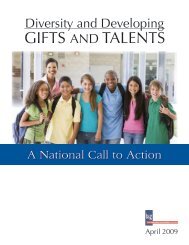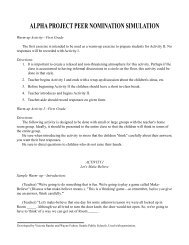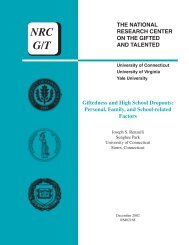Effective Program Design and Implementation Strategies and ...
Effective Program Design and Implementation Strategies and ...
Effective Program Design and Implementation Strategies and ...
- No tags were found...
Create successful ePaper yourself
Turn your PDF publications into a flip-book with our unique Google optimized e-Paper software.
<strong>Effective</strong> <strong>Program</strong> <strong>Design</strong> <strong>and</strong> <strong>Implementation</strong> <strong>Strategies</strong> <strong>and</strong> Practices in Gifted Education E. Jean Gubbins, Ph.D. University of Connecticut 2131 Hillside Road, Unit 3007 Storrs, CT 06269-‐3007 ejean.gubbins@uconn.edu PART IE. J. Gubbins UCONN
<strong>Program</strong> <strong>Design</strong> <strong>and</strong> <strong>Implementation</strong> * Is identification the first step? * How about adopting a curricular model? * Is selecting a service delivery model the most important step? E. J. Gubbins UCONN
<strong>Program</strong> <strong>Design</strong> <strong>and</strong> <strong>Implementation</strong> * Needs Assessment* <strong>Program</strong> Planning* Mission* Goals* Identification* Definitions* Procedures* Curricular Approaches* Models* EvaluationE. J. Gubbins UCONN
E. J. Gubbins UCONN http://www.cde.state.co.us/gt/download/pdf/<strong>Program</strong><strong>Design</strong>.pdf
Sample Key Points for Mission Statements Jonesville School District * Ensure that each child has equal opportunity to receive a suitable program of educational experiences. * Recognize that some students posses, or are capable of possessing, extraordinary learning ability <strong>and</strong>/or outst<strong>and</strong>ing talent. * Represent all socioeconomic, cultural, <strong>and</strong> ethnic backgrounds. E. J. Gubbins UCONN Purcell, J. H., & Eckert, R. D. (2006). <strong>Design</strong>ing services <strong>and</strong> programs for high-‐ability learners: A guidebook for gifted education. Thous<strong>and</strong> Oaks, CA: Corwin Press.
Sample Key Points for Mission Statements Smithville Board of Education * There are gifted students whose intellectual capacity, rate of learning, <strong>and</strong> potential for creative contributions dem<strong>and</strong> experiences apart from, but connected to, the regular classroom. * These students exhibit high performance, or the potential to achieve, in intellectual, creative, or artistic areas; possess strong leadership capacity; or excel in specific academic fields. E. J. Gubbins UCONN Purcell, J. H., & Eckert, R. D. (2006). <strong>Design</strong>ing services <strong>and</strong> programs for high-‐ability learners: A guidebook for gifted education. Thous<strong>and</strong> Oaks, CA: Corwin Press.
Sample Services for Mission Statements Smithville Board of Education * It is essential to provide diverse, appropriate, <strong>and</strong> ongoing learning experiences <strong>and</strong> environments that incorporate the academic, psychological, <strong>and</strong> social needs of students. * It is our responsibility to provide students with educational alternatives that teach, challenge, <strong>and</strong> exp<strong>and</strong> their knowledge, while simultaneously stressing the development of independent <strong>and</strong> self-‐directed learners who continuously generate questions, analyze, synthesize, <strong>and</strong> evaluate information <strong>and</strong> ideas. E. J. Gubbins UCONN Purcell, J. H., & Eckert, R. D. (2006). <strong>Design</strong>ing services <strong>and</strong> programs for high-‐ability learners: A guidebook for gifted education. Thous<strong>and</strong> Oaks, CA: Corwin Press.
1. Provide a variety of appropriate types <strong>and</strong> levels of acceleration <strong>and</strong> enrichment in grades K-‐12 that are based on students’ learning needs. Objective 1: Conduct a needs assessment to determine: (1) the acceleration <strong>and</strong> enrichment options currently offered, <strong>and</strong> (2) the discrepancy between the current offerings <strong>and</strong> what needs to be offered, K-‐12, to address the learning needs of the targeted gifted <strong>and</strong> talented students. Objective 2: Screen all students beginning at age 4 for early entrance into kindergarten. E. J. Gubbins UCONN Objective 3: In grades 6-‐8, an accelerated mathematics curriculum will be offered to students based on their preassessment scores <strong>and</strong> interest.
2. Provide students with learning experiences at an appropriate level of challenge based on preassessment data. Objective 1: Provide ongoing professional development <strong>and</strong> coaching related to preassessment, interpreting preassessment data, <strong>and</strong> differentiation options related to preassessment data. Objective 2: Analyze the trends <strong>and</strong> patterns in gain score data for all students, including the data for gifted <strong>and</strong> talented students. E. J. Gubbins UCONN
3. <strong>Design</strong>, develop, <strong>and</strong> implement high-quality curriculum that is supported by research-‐based models appropriate for gifted students. Objective 1: Assess the overall curriculum quality for gifted <strong>and</strong> talented students using the NAGC Curriculum Division’s rubric for assessing award-‐winning curriculum (Purcell, Burns, Tomlinson, Imbeau, & Martin, 2002). E. J. Gubbins UCONN
4. Ensure that the curriculum for gifted students is aligned with <strong>and</strong> extends the regular classroom curriculum.Objective 1: Gifted education specialists <strong>and</strong> administrators will evaluated the existing continuum of services to establish linkages with local, state, <strong>and</strong> national curriculum st<strong>and</strong>ards. E. J. Gubbins UCONN
<strong>Design</strong>ing Mission Statements Comprehensiveness What is giftedness? How do the intellectual <strong>and</strong> social <strong>and</strong> emotional needs of gifted <strong>and</strong> talented students differ from chronological peers? What is it important that these unique learning needs are met? E. J. Gubbins UCONN Purcell, J. H., & Eckert, R. D. (2006). <strong>Design</strong>ing services <strong>and</strong> programs for high-‐ability learners: A guidebook for gifted education. Thous<strong>and</strong> Oaks, CA: Corwin Press.
<strong>Design</strong>ing Mission Statements Rationale What is the justification or motivation for providing educational services to gifted <strong>and</strong> talented students? Are the policies based on an underst<strong>and</strong>ing of state policies <strong>and</strong> regulations regarding gifted education? What is the research base that supports our conclusions? E. J. Gubbins UCONN Purcell, J. H., & Eckert, R. D. (2006). <strong>Design</strong>ing services <strong>and</strong> programs for high-‐ability learners: A guidebook for gifted education. Thous<strong>and</strong> Oaks, CA: Corwin Press.
<strong>Design</strong>ing Mission Statements Internal Consistency What is the linkage between the broad learning goals for gifted <strong>and</strong> talented students <strong>and</strong> the learning goals for all students in the district or system? E. J. Gubbins UCONN Purcell, J. H., & Eckert, R. D. (2006). <strong>Design</strong>ing services <strong>and</strong> programs for high-‐ability learners: A guidebook for gifted education. Thous<strong>and</strong> Oaks, CA: Corwin Press.
<strong>Design</strong>ing Mission Statements Clarity Is the language clear <strong>and</strong> free of educational jargon?Is it written so that all readers will underst<strong>and</strong> the intent of the document? E. J. Gubbins UCONN Purcell, J. H., & Eckert, R. D. (2006). <strong>Design</strong>ing services <strong>and</strong> programs for high-‐ability learners: A guidebook for gifted education. Thous<strong>and</strong> Oaks, CA: Corwin Press.
<strong>Program</strong> Goals E. J. Gubbins UCONN* To provide an atmosphere for stimulatingbehavior among students who have beenidentified as requiring instruction that isqualitatively different from that of the regularcurriculum. * To provide opportunities for students toparticipate in guided investigative experiences,alone <strong>and</strong> in small groups, using diversehuman, material, <strong>and</strong> technical resources.
<strong>Program</strong> Goals * To encourage the development of a healthy selfconcept,a broad tolerance for oneself <strong>and</strong> others,<strong>and</strong> promote the concept of task commitment. * To broaden students’ cultural environment <strong>and</strong>develop an openness to new experiences byexposing them to the creative arts that will enrichtheir talents, stimulate their creativity, <strong>and</strong> developthis potential. E. J. Gubbins UCONN
<strong>Program</strong> Goals * To provide opportunities for students to produce <strong>and</strong> evaluateproducts in areas of personal interests. * To implement the principles of divergent <strong>and</strong> convergentthinking. * To serve as a resource to regular classroom teachers in thedevelopment of enrichment activities in both cognitive <strong>and</strong>affective areas. E. J. Gubbins UCONN
Student Goals* Information Processing* To develop the ability to gather, organize, analyze, <strong>and</strong> applyinformation* Problem Solving* To develop the ability to identify, define, analyze, develop, <strong>and</strong>assess possible problem solutions.* Critical Thinking* To develop the ability to use critical/reflective thinking focusedon deciding what to do or believe. This includes supporting ideaswith facts <strong>and</strong>/or logic <strong>and</strong> explaining relationships.E. J. Gubbins UCONN Rockwood, MO Gifted <strong>Program</strong>
Student Goals* Communication* To develop the ability to plan, create, <strong>and</strong> present verbal, visual,<strong>and</strong> written information in order to effectively share thoughts<strong>and</strong> ideas with others.* Responsibility* To develop the ability to work productively <strong>and</strong> independentlyas an individual, to be a positive group member, <strong>and</strong> todemonstrate effective leadership skills.E. J. Gubbins UCONN
NAGC St<strong>and</strong>ard 1: Learning <strong>and</strong> Development Student Outcomes Evidence-‐Based Practices 1.1 Self-‐Underst<strong>and</strong>ing. Students with gifts <strong>and</strong> talents demonstrate self-‐knowledge with respect to interests, strengths, identities, <strong>and</strong> needs in socio-‐emotional development <strong>and</strong> in intellectual, academic, creative, leadership, <strong>and</strong> artistic domains. 1.6 Cognitive <strong>and</strong> Affective Growth. Students with gifts <strong>and</strong> talents benefit from meaningful <strong>and</strong> challenging learning activities. 1.7 Cognitive <strong>and</strong> Affective Growth. Students with gifts <strong>and</strong> talents recognize their preferred approaches to learning <strong>and</strong> exp<strong>and</strong> their repertoire. 1.1.1 Educators engage students with gifts <strong>and</strong> talents in identifying interests, strengths, <strong>and</strong> gifts. 1.6.1 Educators design interventions for students to develop cognitive <strong>and</strong> affective growth that is based on research of effective practices. 1.7.1 Teachers enable students to identify their preferred approaches to learning, accommodate these preferences, <strong>and</strong> exp<strong>and</strong> them. Abbreviated National Association for Gifted St<strong>and</strong>ards E. J. Gubbins UCONN
E. J. Gubbins UCONN
Talent DevelopmentlatentemergentmanifestE. J. Gubbins UCONN The National Research Center on the Gifted <strong>and</strong> Talented, University of Connecticut, Storrs, CT
CurrentIndependentAchievementsZZ Zone of ProximalDevelopmentAchievementswith ScaffoldingLev Vygotsky (1896-‐1934) E. J. Gubbins UCONN
Vygotsky: Zone of Proximal Development(ZPD) Too difficult tobe engaging2. Assistance providedby self Too Simple to beengaging1. Assistance providedby more capableothers: teachers,peers, coaches,experts, parents E. J. Gubbins UCONN Robin m. schader 2006
E. J. Gubbins UCONN
Personal Characteristics“…high performancecapability in intellectual,creative, <strong>and</strong>/or artisticareas, possess an unusualleadership capacity…”“… excel in specificacademic fields …”R. M. SchaderChanceSchool <strong>and</strong>Home InfluenceE. J. Gubbins UCONNBased on Gagné’s DMGT
National Association For Gifted Children* Gifted individuals are those who demonstrateoutst<strong>and</strong>ing levels of aptitude (defined as an exceptionalability to reason <strong>and</strong> learn) or competence (documentedperformance or achievement in top 10% or rarer) in oneor more domains. Domains include any structured areaof activity with its own symbol system (e.g., mathematics,music, language) <strong>and</strong>/or set of sensorimotor skills (e.g.,painting, dance, sports).E. J. Gubbins UCONN
National Association For Gifted Children* The development of ability or talent is a lifelong process. It can beevident in young children as exceptional performance on tests <strong>and</strong>/or other measures of ability or as a rapid rate of learning, comparedto other students of the same age, or in actual achievement in adomain.* As individuals mature through childhood to adolescence, however,achievement <strong>and</strong> high levels of motivation in the domain becomethe primary characteristics of their giftedness. Various factors caneither enhance or inhibit the development <strong>and</strong> expression ofabilities.E. J. Gubbins UCONN
National Association For Gifted Children* A person's giftedness should not be confused with the means bywhich giftedness is observed or assessed. Parent, teacher, orstudent recommendations, a high mark on an examination, or ahigh IQ score are not giftedness; they may be a signal thatgiftedness exists. Some of these indices of giftedness are moresensitive than others to differences in the person's environment.E. J. Gubbins UCONN
Commonalities Among Promising Practices * Acceptance of intelligence as multifaceted * Emphasis on talent development over time * Philosophy of inclusiveness * Emphasis on behaviors of high performance * Recognition of behaviors of high performance * Recognition of intelligence evident in culturallyspecific ways Callahan, C. M., Tomlinson, C. A., & Pizzat, P. M. (Eds.). (n.d.). Contexts for promises: Noteworthy practices<strong>and</strong> innovations in the identification of gifted students. Charlottesville, VA: University of Virginia.E. J. Gubbins UCONN
* Who are the gifted <strong>and</strong> talented students? * Why are we striving to find them? * How do we find them? E. J. Gubbins UCONN
E. J. Gubbins UCONN Academic Abilities Group Administered Tests Spring of grades 2-‐11 Talent Pool 85 th percentile (local norms)—Achievement Test 120 or above—Intelligence Test Teacher Ratings Learning, Motivation, Creativity Alternative Tools Nominations Self, Peer, Teacher, Administrator, Parent Academic Grades Writing Samples Students’ Educational Profiles Academic Achievements <strong>and</strong> Accomplishments Case Studies Continuum of <strong>Program</strong>s & Services Match Talents <strong>and</strong> Abilities to Goals Gubbins, E. J. (2006). Constructing identification procedures. In J. H. Purcell & R. D. Eckert, <strong>Design</strong>ing services <strong>and</strong> programs for high-‐ability learners: A guidebook for gifted education (pp. 49-‐61). Thous<strong>and</strong> Oaks, CA: Corwin Press.
Artistic Talents & Abilities Nominations Self, Peer, Teacher, Administrator, Parent Teacher Ratings Art, Music, Dance, Theater Portfolios Guided Collection Related to Artistic Talents <strong>and</strong> Abilities Performances Auditions, Presentations, Juried Shows, Recitals Students’ Educational Profiles Ratings of Panel of Artists Case Studies Continuum of <strong>Program</strong>s & Services Match Talents <strong>and</strong> Abilities to Goals E. J. Gubbins UCONN Gubbins, E. J. (2006). Constructing identification procedures. In J. H. Purcell & R. D. Eckert, <strong>Design</strong>ing services <strong>and</strong> programs for high-‐ability learners: A guidebook for gifted education (pp. 49-‐61). Thous<strong>and</strong> Oaks, CA: Corwin Press.
* What are the most appropriate tools for identifying students’ gifts <strong>and</strong> talents? * How are the data from various tools analyzed <strong>and</strong> interpreted? * Who is responsible for identifying students’ gifts <strong>and</strong> talents? E. J. Gubbins UCONN
* Test Data * Individual intelligence test * Group intelligence test * Creativity test * Norm-‐referenced achievement test * Criterion-‐referenced test * Academic grades * Nomination * Teacher * Parent * Student * Biographical or Autobiographical Data * Interview * Case study * Narrative or anecdotal recommendation * Activity-‐based Assessment * Developmental identification * Diagnostic placement * Responses to improvised activities * Evaluation of Student Work * Product review * Portfolio review * Audition * Rating Scales or Behavioral Checklist * Teacher * Parent * Student E. J. Gubbins UCONN Del Siegle
Is Our Identification System <strong>Effective</strong>?Provides logical, direct statements of where to start the processPublic information in written formReflects characteristics of student populationIncorporates multiple tools to document students’ abilities <strong>and</strong> talentsReflects students’ needs <strong>and</strong> definition of giftednessE. J. Gubbins UCONN
Comprehensive Multiple Measures Assessment & Intervention Theory-‐Based Theory-‐Based Codified E. J. Gubbins UCONN
NAGC St<strong>and</strong>ard 2: Assessment Student Outcomes 2.1 Identification. All students (grades PK-‐12) have equal access to comprehensive assessment system 2.2 Identification. Each student reveals exceptionalities through assessment 2.3 Identification. Students with identified needs represent diverse backgrounds Evidence-‐Based Practices 2.1.1. Educators develop environments <strong>and</strong> instructional activities for gifted students 2.2.1 Educators establish comprehensive, cohesive, <strong>and</strong> ongoing identification procedures 2.3.1 Educators select <strong>and</strong> use non-‐biased approaches for identification 2.4 Learning Progress <strong>and</strong> Outcomes. Students with gifts <strong>and</strong> talents demonstrate advanced <strong>and</strong> complex learning. E. J. Gubbins UCONN 2.4.1 Educators use differentiated pre-‐ <strong>and</strong> post-‐performance based assessments to measure progress Abbreviated National Association for Gifted St<strong>and</strong>ards
Mary M. Frasier (1992) E. J. Gubbins UCONN
Curriculum Considerationsn All students should experience highquality,engaging, intellectually challengecurriculum that meets their present <strong>and</strong>future academic needs.n Such curriculum not only will develop theabilities of gifted students; it also will helpidentify advanced potential in otherstudents.E. J. Gubbins UCONN
Curriculum Considerationsn The needs of gifted students are different thanthose of others. Curriculum must be adaptedor designed to accommodate these needs.n As the gifted student moves toward expertisein a discipline, the level of intellectualdem<strong>and</strong> provided for the student shouldescalate in accordance with his or herindividual growth.E. J. Gubbins UCONN
Curriculum Considerationsn All high-quality curriculum should containkey components, or “organizers,” thatmake the materials meaningful for learners.n Appropriate curriculum activities for giftedstudents cut across these areas: cognitive,(e.g., their precocity), affective (e.g., theirmotivational intensity), <strong>and</strong> social (e.g.,their need for intellectual peers).Davis, G. A., Rimm, S. B., & Siegle, D. (2011). Education of the gifted <strong>and</strong> talented(6th ed.). Boston, MA: Allyn <strong>and</strong> Bacon. E. J. Gubbins UCONN
E. J. Gubbins UCONN
Developing Thinking SkillsThinking of Thinking• Teaching particular mental skills as the primary purpose of instruction.Thinking for Thinking• Helping students be more conscious of their own thinking process.Thinking About Thinking• Creating school conditions conducive to students’ thinking.E. J. Gubbins UCONN Art Costa
TAXONOMY OF COGNITIVE & AFFECTIVEPROCESSES(The "Type II Matrix" JSR: 2001)I. Cognitive Thinking SkillsA. Creative Thinking SkillsB. Creative Problem-Solving & Decision-MakingC. Critical <strong>and</strong> Logical ThinkingII. Character Development <strong>and</strong> Affective Process SkillsA. Character DevelopmentB. Interpersonal SkillsC. Intrapersonal SkillsIII. Learning How-To Learn SkillsA. Listening, Observing, & PerceivingB. Reading, Notetaking, & OutliningC. Interviewing & SurveyingD. Analyzing & Organizing DataIV. Using Advanced Research Skills & ReferenceMaterialsA. Preparing for Research & Investigative ProjectsB. Library & Electronic ReferenceC. Finding & Using Community ResourcesE. J. Gubbins UCONN V. Written, Oral, <strong>and</strong> Visual Communication SkillsA. Written Communication SkillsB. Oral Communication SkillsC. Visual Communication Skills
Type II Thinking Skills TaxonomyCRITICAL AND LOGICAL THINKING SKILLSInferences Sequencing Translation Ambiguity Flow Charting Interpretation Fallacies Analogies Extrapolation Emotive Words Conditional Reasoning Inductive Reasoning Patterning Deductive Reasoning Probability Classification Syllogisms Dilemmas Validity Testing Reliability Testing Paradoxes Analysis of: Content, Elements, Trends & Patterns, Relationships, Organizing Principles, Propag<strong>and</strong>a & Bias E. J. Gubbins UCONN
Original TermsNew Terms* Evaluation* Synthesis* Analysis* Application* Comprehension* Knowledgeu Creatingu Evaluatingu Analyzingu Applyingu Underst<strong>and</strong>ingu RememberingE. J. Gubbins UCONN (Based on Pohl, 2000, Learning to Think, Thinking to Learn, p. 8)
NAGC St<strong>and</strong>ard 3: Curriculum Planning & Instruction Student Outcomes 3.1 Curriculum Planning. Students with gifts <strong>and</strong> talents demonstrate growth commensurate with aptitude. 3.2 Talent Development. Students with gifts <strong>and</strong> talents become more competent in multiple areas. 3.4 Instructional <strong>Strategies</strong>. Students with gifts <strong>and</strong> talents become independent investigators. 3.4 Instructional <strong>Strategies</strong>. Students with gifts <strong>and</strong> talents become independent investigators. Evidence-‐Based Practices 3.1.1. Educators used local, state, <strong>and</strong> national st<strong>and</strong>ards to align <strong>and</strong> exp<strong>and</strong> curriculum <strong>and</strong> instructional plans. 3.2.1 Educators design curricula in cognitive, affective, aesthetic, social, <strong>and</strong> leadership domains that are challenging. 3.4.1 Educators use critical thinking strategies 3.4.3 Educators use problem solving model strategies thinking strategies Abbreviated National Association for Gifted St<strong>and</strong>ards E. J. Gubbins UCONN
<strong>Effective</strong> <strong>Program</strong> <strong>Design</strong> <strong>and</strong> <strong>Implementation</strong> <strong>Strategies</strong> <strong>and</strong> Practices in Gifted Education E. Jean Gubbins, Ph.D. University of Connecticut 2131 Hillside Road, Unit 3007 Storrs, CT 06269-‐3007 ejean.gubbins@uconn.edu PART IIIE. J. Gubbins UCONN
MJ Valenzuela Individual Plans Accelera2on Curriculum-‐ Based Differen2a2on Part-‐Time No clear defini5on of “gi8ed” Not defensible E. J. Gubbins UCONN
Joyce VanTassel-‐Baska Advanced Content Dimension• Accelerated pace• Diagnostic-prescriptive instructionalapproach• Curriculum compacting• Goals/outcomes of unit• Identify mastered skills• Provide replacement activitiesProcess-Product Dimension• Problem-based learning• Critical thinking• Deductive reasoning• Higher-level thinkingIssues/Themes Dimension• Socratic questioning• Interdisciplinary Thinking• Core concept as an organizerwithin a subjectIntegratedCurriculumModelE. J. Gubbins UCONN Kimberly Webster, 2012
Sarah Heist, 2012 E. J. Gubbins UCONN Promo5ng Excellence: Accelera5on Through Enrichment (Assouline, Bl<strong>and</strong>o, Cro8, Baldus, & Colangelo) Introduc5on Pre-‐Implementa5on Early Implementa5on Curriculum Implementa5on/Student Involvement Post-‐Iowa Excellence Professional Development AP Courses Available for Prepared High School Students Dynamic Partnership between University <strong>and</strong> K-‐12 Prepara5on for <strong>Program</strong> Implementa5on Professional Prepara5on for Iowa Excellence "Discovery" of Students Qualified for Iowa Excellence via Above-‐Level Tes5ng Enhanced Achievement in Math <strong>and</strong> Science as Prepara5on for Accelerated Courses in High School Prepara5on of High School Teachers to Teach Accelerated Courses Accelera5on (AP) in High School LeUers of University Support LeUers of District Commitment Iden5fy: <strong>Program</strong> Coordinator & Qualified Teachers Determine: Loca5on, Schedule & <strong>Program</strong> Funding Establish: Mode of Communica5on Professional Developent for Gi8ed Educa5on <strong>and</strong> Math <strong>and</strong> Science Content Administra5on of Above-‐Level Tests Iden5fica5on of <strong>Program</strong> Par5cipants 96 Hours of Supplementary Math <strong>and</strong> Science Instruc5on Over Each Academic Year for 3 Years (grades 6-‐8) AUend AP Training Prior to Teaching an AP Class Establish Commitment with University-‐Supported Online <strong>Program</strong> Iowa Online Advanced Placement Academy (IOAPA)
Problem-Based Learningby Shelagh A. GallagherTeacher’s role=facilitator 1. Problem Engagement 2. Inquiry <strong>and</strong> Inves2ga2on 3. Problem Defini2on 4. Problem Resolu2on 5. Problem Debriefing Ill structured problem that drives the learning experience Students’ views= Perspec2ves of stakeholders By Victoria Miller Flexible yet structured E. J. Gubbins UCONN
Integrated Curriculum Model" Comprehensive <strong>and</strong> cohesive curricularframework that employs good curricular design,considers the features of the disciplines understudy, <strong>and</strong> is differentiated for gifted learners" Simultaneously addresses precocity, intensity, <strong>and</strong>complexity" Addresses cognitive <strong>and</strong> affective dimensions of thegifted learnerJoyce VanTassel-BaskaE. J. Gubbins UCONN
Integrated Curriculum ModelIssues/Themes/DimensionAdvancedContentDimensionProcess-ProductDimensionE. J. Gubbins UCONNVanTassel-Baska
IntegratedCurriculumModel" Emphasizes advancedcontent knowledge" Provides higher orderthinking <strong>and</strong> processing" Organizes learningexperiences around majorissues, themes, <strong>and</strong> ideas thatdefine underst<strong>and</strong>ing of adiscipline <strong>and</strong> provideconnections acrossdisciplinesE. J. Gubbins UCONNVanTassel-Baska
E. J. Gubbins UCONNVanTassel-Baska
Key words:Interesting words& phrasesFeelings: yours &charactersIdeas: main ideaStructure: literary& style elementsImages & Symbols:description &imageryE. J. Gubbins UCONN
Purpose/GoalPoint of ViewImplications/ConsequencesEvidence/DataISSUE/PROBLEMInferencesConcepts/IdeasAssumptionsE. J. Gubbins UCONN
Ancient Egypt: How Do We Know?To explore the value of various sourcesin studying history.To introduce the writing system ofancient Egypt.To explore the history of translatingEgyptian hieroglyphs.To introduce the educational system ofancient Egypt.VanTassel-Baska, J., Avery, L. D., Little, C. A. (2003). Ancient Egypt: Gift of the Nile.Dubuque, IA: Kendall Hunt.E. J. Gubbins UCONN
Why do you think Champollian <strong>and</strong> the French wantedto figure out what the Egyptian writing meant?What was their purpose oftrying to find out?In order for Champollian to figure out whatthe hieroglyhs meant, first he had to drawconclusions or make the inference that thethree different languages all said the samething?VanTassel-Baska, J., Avery, L. D., Little, C. A. (2003). Ancient Egypt: Gift of the Nile. Dubuque, IA:Kendall Hunt.E. J. Gubbins UCONN
T he Schoolwide Enrichment ModelJoseph S. Renzulli & Sally M. ReisSchool StructuresThe Total Talent PortfolioCurriculum Modification TechniquesEnrichment Learning <strong>and</strong> TeachingTYPE IGENERALEXPLORATORYACTIVITIESTYPE IIGROUPTRAININGACTIVITIESTYPE IIIINDIVIDUAL & SMALL GROUPINVESTIGATIONS OF REAL PROBLEMSE. J. Gubbins UCONNRegularClassroomEnvironmentService Delivery Componentswww.gifted.uconn.edu
E. J. Gubbins UCONNOrientationIn-depthStudyIndividualDevelopmentAutonomous LearnerSeminarsEnrichment
Autonomous Learner ModelOrientationUnderst<strong>and</strong>ing Giftedness, Talent, Intelligence,& CreativityGroup Building ActivitiesSelf/Personal Development<strong>Program</strong> & School Opportunities &ResponsibilitiesE. J. Gubbins UCONNBetts
Autonomous Learner ModelIndividual DevelopmentIntra/interpersonal skillsLearning SkillsTechnologyCollege & CareerReadinessOrganizational SkillsEnrichmentExplorationsInvestigationsCultural ActivitiesServiceAdventure TripsProductivityE. J. Gubbins UCONN
Autonomous Learner ModelSeminarsFuturisticProblematicControversialGeneral InterestAdvanced KnowledgeIn-depth StudyIndividual ProjectsGroup ProjectsMentorshipsPresentationsAssessmentE. J. Gubbins UCONN
OBSTACLES!"Family Circumstances"FAMILY SUPPORT!Family sacrifice"Extended families"FLOW"SUCCESS FACTORS!Lack of InstructionalOpportunities"INSTRUCTION!Talent identification"Professional instructors/role models"Professional environment"Peer Pressure"COMMUNITY SUPPORT!Adult supervision"Peer group"School support"Dreams vs. Realities"RESILIENCE"SELF-REGULATION"PERSONAL CHARACTERISTICS!Early interest"Cultural values"Sense of professionalism"IDENTITY"E. J. Gubbins UCONN Oreck, B., Baum, S., & McCartney, H. (2000). Artistic talent development for urban youth: The promise <strong>and</strong> thechallenge. Storrs, CT: University of Connecticut, The National Research Center on the Gifted <strong>and</strong>Talented.
Activities E. J. Gubbins UCONN http://www.copyblogger.com/critical-‐thinking/
*KnowledgeAttitudeAspirationBehaviorConceptual underst<strong>and</strong>ing ofinformation, theories, principles, <strong>and</strong>researchBeliefs about the value of particularinformation or strategiesDesires, or internal motivation, toengage in a particular practiceConsistent application <strong>and</strong>knowledge <strong>and</strong> skillsKillion, J. (2003). Training manual for assessing impact: Evaluating staff development. Oxford, OH: National StaffDevelopment Council, p. 159.E. J. Gubbins UCONN
E. J. Gubbins UCONNDefinition ofEvaluationEvaluation is a form of disciplined inquiry, thepurpose of which is to produce information to assistin making informed value judgments about somephenomena.Brighton, C. M., Brown, E., Gubbins, E. J., & Moon, T. R. (2005, November), Institute on gifted program evaluation: Evaluatingthe effectiveness of services for gifted children. Presentation at National Association for Gifted Children, Columbus, OH.
http://instructionaldesign<strong>and</strong>training.blogspot.com/2011/05/addie-evaluationphase.htmlE. J. Gubbins UCONN
Key Features of Evaluation—J. S. Renzulli REVIEW OFPROGRAMRECORDS"ADMINISTERINSTRUMENTS!CONDUCTINTERVIEWS!NARRATIVE!CONDUCTOBSERVATIONS!STATISTICAL!OPEN-ENDEDQUESTIONNAIRES"SELECT" ADAPT" CONSTRUCT"GRAPHIC!INTERVIEWS"WITHREPRESENTATIVESOF PRIME"INTEREST"GROUPS"OBSERVATIONS"TESTS!!!!RATING SCALES!!!!CHECKLISTS!!!OBSERVATIONALSYSTEMS!!!!SOCIOGRAMS!!QUESTIONNAIRES!!!!LOGS!!!!INTERVIEWSCHEDULES!!ANECDOTALRECORDINGSYSTEMS!!!INVENTORIES!TABULATE!ANALYZE!SUMMARIZE!RECOMMEND!Front-End Analysis (Input)!E. J. Gubbins UCONNSynthesis of Input Information!A.!DEVELOPING OF A DATA GATHERINGMATRIX!B.!INSTRUMENT DEVELOPMENT!Data Collection <strong>and</strong> Analysis!File Evaluation Report!A.!INTERIM!B.!BRIEFS!C.!FINAL!
Gifted Children’s Bill of Rightsn Gifted children have a right to know abouttheir giftedness.n Gifted children have a right to learnsomething new every day.n Gifted children have a right to bepassionate about their talent areas withoutapologies.—Siegle, 2007E. J. Gubbins UCONN
Gifted Children’s Bill of Rightsn Gifted children have a right to have anidentity beyond their talent area.n Gifted children have a right to feel goodabout their accomplishments.n Gifted children have a right to makemistakes.n Gifted children have a right to seekguidance in the development of their talent.—Siegle, 2007E. J. Gubbins UCONN
Gifted Children’s Bill of Rightsn Gifted children have a right to havemultiple peer groups <strong>and</strong> a variety offriends.n Gifted children have a right to choosewhich of their talent areas they wish topursue.n Gifted children have a right not to be giftedat everything.E. J. Gubbins UCONN—Siegle, 2007
Resources National Association for Gifted Children. (2010). Pre-‐K-‐12 Gifted <strong>Program</strong>ming St<strong>and</strong>ards. Retrieved from http://www.nagc.org/uploadedFiles/Information_<strong>and</strong>_Resources/Gifted_<strong>Program</strong>_St<strong>and</strong>ards/K-‐12%20programming%20st<strong>and</strong>ards.pdf Lord, E. W., & Cotabish, A. (2010). Snapshot survey of gifted programming effectiveness factors. Retrieved from nagc.org. E. J. Gubbins UCONN



